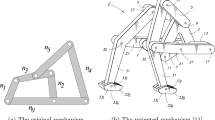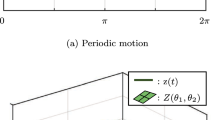Abstract
We study the dynamics of pairs of connected masses in the plane when non-holonomic (knife-edge) constraints are realized by forces of viscous friction, in particular its relation to constrained dynamics, and its approximation by the method of matching asymptotics of singular perturbation theory when the mass-to-friction ratio is taken as the small parameter. It turns out that long-term behaviors of the frictional and constrained systems may differ dramatically no matter how small the perturbation is, and when this happens is not determined by any transparent feature of the equations of motion. The choice of effective time scales for matching asymptotics is also subtle and non-obvious, and secular terms appearing in them cannot be dealt with by the classical methods. Our analysis is based on comparison to analytic solutions, and we present a reduction procedure for plane dumbbells that leads to them in some cases.











Similar content being viewed by others
References
Borisov A, Mamaev I (2002) On the history of the development of the nonholonomic dynamics. Regul Chaotic Dyn 7(1):43–47
Lewis A, Murray R (1995) Variational principles for constrained systems: theory and experiment. Int J Non-Linear Mech 30(6):793–815
Marle C-M (1998) Various approaches to conservative and nonconservative nonholonomic systems. Rep Math Phys 42(1–2):211–229
Greenwood D (1998) Advanced dynamics. Cambridge University Press, Cambridge
Benenti S (2008) A general method for writing the dynamical equations of nonholonomic systems with ideal constraints. Regul Chaotic Dyn 13(4):283–315
Zekovich D (1993) On the motion of an integrable system with a nonlinear nonholonomic constraint. Mosc Univ Math Bull 48(1):37–41
Carathéodory C (1933) Der Schlitten. Z Angew Math Mech 13(2):71–76
Fufaev N (1964) On the possibility of realizing a nonholonomic constraint by means of viscous friction forces. J Appl Math Mech 28(3):630–632
Neimark J, Fufaev N (1972) Dynamics of nonholonomic systems. Translations of mathematical monographs 33. American Mathematical Society, Providence
Brendelev A (1981) On the realization of constraints in nonholonomic mechanics. J Appl Math Mech 45(3):481–487
Karapetian A (1981) On realizing nonholonomic constraints by viscous friction forces and Celtic stones stability. J Appl Math Mech 45(1):30–36
Arnold V, Kozlov V, Neishtadt A (2006) Mathematical aspects of classical and celestial mechanics. [Dynamical systems III]. Encyclopaedia of Mathematical Sciences 3. Springer, Berlin
Kozlov V (1983) Realization of nonintegrable constraints in classical mechanics. Sov Phys Dok 28:735–737
Eldering J (2016) Realizing nonholonomic dynamics as limit of friction forces. Reg Chaotic Dyn 21(4):390–409
Fenichel N (1972) Persistence and smoothness of invariant manifolds for flows. Indiana Univ Math J 21(3):193–226
Deppler J, Braun B, Fidlin A, Hochbruck M (2016) Convergence of viscoelastic constraints to nonholonomic idealization. Eur J Mech A Solids 58:140–147
Verhülst F (2005) Methods and applications of singular perturbations. Texts in applied mathematics, vol 50. Springer, New York
Holmes M (1995) Introduction to perturbation methods. Texts in applied mathematics, vol 20. Springer, New York
Hek G (2010) Geometric singular perturbation theory in biological practice. J Math Biol 60:347–386
Zagaris A, Kaper H, Kaper T (2003) Analysis of the computational singular perturbation reduction method for chemical kinetics. J Nonlinear Sci 14(1):59–91
Bahar L (1998) A non-linear non-holonomic formulation of the Appell–Hamel problem. Int J Nonlinear Mech 33(1):67–83
Koiller J (1992) Reduction of some classical nonholonomic systems with symmetry. Arch Ration Mech Anal 118(2):113–148
Korenev B (2002) Bessel functions and their applications. Analytical methods and special functions, vol 8. Taylor & Francis, London
Acknowledgements
The authors are grateful to Jaap Eldering for multiple suggestions and corrections during the preparation of the paper.
Author information
Authors and Affiliations
Corresponding author
Rights and permissions
About this article
Cite this article
Koshkin, S., Jovanovic, V. Realization of non-holonomic constraints and singular perturbation theory for plane dumbbells. J Eng Math 106, 123–141 (2017). https://doi.org/10.1007/s10665-017-9896-8
Received:
Accepted:
Published:
Issue Date:
DOI: https://doi.org/10.1007/s10665-017-9896-8




